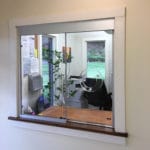Ballistic Protection Standards and Meaning
 Adding bullet resistant glass, bullet proof doors, windows, or entryway features is a great option for improving security at schools, banks, or corporate facilities. These products are available in several varieties and configurations, so it’s important to educate yourself on the different types available in order to make the best choice for your particular building.
Adding bullet resistant glass, bullet proof doors, windows, or entryway features is a great option for improving security at schools, banks, or corporate facilities. These products are available in several varieties and configurations, so it’s important to educate yourself on the different types available in order to make the best choice for your particular building.
There are universal ballistic protection standards used to ensure testing uniformity for the available products and components and to help people make sense of the options. Here’s a quick explanation reviewing the different levels of ballistic protection and what they mean for companies and organizations looking to invest in bullet resistant glass.
What Are Ballistic Protection Standards for Bullet Resistant Glass?
There are eight different bulletproof levels for glass; however, it should be noted that no material is technically “bulletproof.” The materials are simply bullet resistant, meaning they can withstand different types of ballistic projectiles without shattering or allowing bullets to travel through the glass at full speed.
The eight levels are designated by the Underwriter’s Laboratory (UL) under UL752 standards for bullet resistance.
The different numbers correspond to the types of firearms and bullets that each one can withstand.
Levels one, two, and three offer protection against various handguns up to a .44 magnum. The higher levels of protection through level eight offer protection against rifle rounds and higher velocity military assault weapons.
Underwriter’s Laboratory has specific tests that must be completed in order for each type of glass to be classified and labeled to a specific level. So once you’ve determined the level of protection your building requires, you can find the level that corresponds with that need and know that any glass baring that UL label with that standard has been tested to live up to that level of protection.
How to Choose the Right Level of Bullet Resistant Glass
Since level-eight bullet resistant glass is made to stand up to the highest powered weapons, many people assume that it’s the best option for every building, but the levels aren’t meant to signify that one type of glass is necessarily better than others.
It’s just about finding the level of protection that best fits the needs of the particular building and its corresponding budget.
Small-caliber handguns are the firearms most commonly used in robberies and similar instances, so choosing a level one or two bullet resistant glass can still be a very safe and effective option for many companies and organizations. Additionally, having any type of bullet resistant glass can sometimes serve as a deterrent for crime or violence.
Essentially, the choice will come down to each building’s specific needs and what they can spend on hardening their structures. Creating a higher level of protection with thicker panels and materials does tend to increase the cost; however, certain building projects may call for that higher level of protection. If you’re interested in learning more, Insulgard offers several resources about our bullet resistant doors and the testing processes required for each level of protection.

